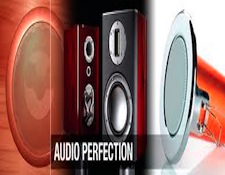It’s the time of year for saving money!

Do you know the story about the
farmer who said “I’m not greedy for land; I just want what joins mine.”? Even
though carrying such a practice to its logical extreme could wind-up with the
farmer eventually owning the entire planet or – given space travel – the entire
universe, I can still understand how that farmer might actually believe that
what he was saying was reasonable. After all, audiophiles say the same sort of
thing all the time.
When audiophiles say it,
though, they put it a little differently: “No,” they’ll tell everyone, especially
themselves, “I am NOT trying for sonic perfection – I know that that’s
impossible — it’s just that my system has this (Let’s call it “Thing L”)
that’s really annoying me”
The problem is that every
system and every one of the components that make it up has an entire alphabet
of sonic characteristics (“Thing A” through “Thing Z”) that can eventually
drive you nuts and that can eventually need to be fixed or gotten rid of.
It works sort of like
this: My system, which I love and was
completely satisfied with when I first bought it, is starting to lose a little
of its luster… After a whole lot of serious listening to a whole lot of different
program material, I’ve figured out what’s bothering me: There’s something wrong
with the “Thing L”, but now that I know that’s what it is, I can just ignore it…
Now that I know that there’s a “Thing L” problem, I CAN’T ignore it… No matter
what I play, that’s the only thing I find myself listening to…
Eventually, something about
the system that was, at first, not even noticeable becomes an obsession and something
has to be done about it. But how can that be? If it’s such a problem now, how
could we not have noticed it before?

It all has to do with how
people listen. Instead of taking in all that’s there, people really just hear
whatever it is about the music or the sound that “turns them on”; and we all
get turned-on by different things. Women, for example, tend to listen to the
words of songs, and to care less about either the music or the sound. That’s
why, unlike us, they always seem to know the words to every song, and why there
are so few female audiophiles. Men, on the other hand, tend to pay less
attention to the words and more to the music and the sound, and the results are
obvious.
Even among men, though – even
men who might reasonably be expected to have a “trained” ear – different people
listen for different things: For me, it’s imaging and soundstaging. For one
manufacturer I know, it’s the attack and decay of transients. For another it’s “harmonic
richness”. One friend of mine who’s a reviewer for a major magazine listens for
“believability”; another likes his sound “quick” and bright and another likes
it “slow”, and chocolate-brown. Outside the industry, it’s just the same: For
some people, the bass is the thing to listen for; for others it’s the treble;
or “clarity”, or “dynamics” or “freedom from distortion”. I’ve even met people
who don’t care much at all about what the music sounds like, as long as it’s head-crushingly
LOUD.
All of these different
characteristics – loud, bright, clear, dynamic, and so on – are the “letters”
of that sonic alphabet I mentioned earlier. Every system and every component has
them all in varying degree and, because we each give them different priority,
it’s like we’re all reading different books; all written in the same language,
with the same alphabet, but with the letters arranged differently. That may be
why “double blind” testing of cables or equipment so often fails; perhaps the
testers don’t agree simply because they’re all listening for different things.
To us as audiophiles, an even
more important thing may be that, even though when we first listen to something
we will hear whatever is most important to us; as we listen more and become
more familiar with a system or a component or even a particular recording, we
start to hear more of those “letters” that we missed the first few times
around. That’s why we don’t hear that annoying “Thing L” when we first buy the
system, but notice it and come to find it increasingly unbearable as time goes
on.

It’s also one of the prime
reasons why we keep having the same experience over and over again: Imagine
that, having nailed-down what’s annoying us, we discover, by long hours of
critical listening and repeated substitution of both components and program
material, that its source is our preamp. Aha! We cry, and take off for our
dealer or the internet or the reviews or the wisdom of our audiophile friends
to find a preamp that has great “Thing L”.
Let’s suppose that we find one, and buy it, and take it home, and put it
into our system, and listen to all of our favorite or most revealing records or
CDs and we LOVE it and we let out a long sigh of satisfaction and settle down
to a day or a month or a year or even more of loving our system again, until,
at some time later, we discover that… there’s a little problem with “Thing J”.
Isn’t that exactly like the
farmer with the perpetual desire for more land? We’re not after perfection. We
know that that’s impossible. All we really want to do is to solve this one
little problem…





